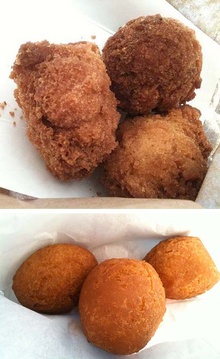As a child, Little Tokyo was my stomping grounds. My mom was a member of the Little Tokyo Library, and it felt like every other weekend we made the hot car ride into LA just so I could sit in the back of her meetings with my coloring books. After the meetings, my brother and I loved playing on the huge two-rock sculpture in front of the JACCC. We frequented the JANM, visiting the Children’s Courtyard so we could see our names in the stone. But as we grew older and our schedules grew busier, the family visits in to LA eventually slowed.
Even though we were no longer in Little Tokyo, my brother and I still had shreds of our heritage to cling to. As children, we both attended culture camps, but closer to home, in Gardena. We tried to learn the language; I was sent to Gardena Buddhist Church every Saturday for a few grueling hours, trying to remember my rus from my ros, while my brother tried his luck at Gardena Valley JCI. Try as we might, the language evaded us year after year. Although we may have blundered while talking to Bachan, the one thing we were really able to get behind was Japanese carnivals.
While memories of those Saturdays may be a bit sour, I still look back fondly on the weekend carnivals that only summer could bring. Almost immediately after school ended, JCI carnival came to town. I remember it as the first taste of dango for the summer, the only Saturday my basketball coach ever let us off the hook for practice, and the only place for Pachinko. Not to mention the bake sale, Jingle Board, and the nice man on the second floor whose art class let you make one free bracelet (and would only smile if you went back to make a second free bracelet on Sunday).
My other childhood tradition came towards the end of the summer. Always the last of the season, Gardena Buddhist Church’s Obon would be the final chance for dango for a good nine months. As a child, Gardena Obon was where I’d see my friends all dressed up (those who were more organized in kimonos whose obis left them breathless, while the less formal of us wore hopi coats and flip flops). We’d dance the night away to the beat of the taiko drum, shuffling our feet in the chalk lines, only stopping with a final gassho before running to the Bounce House and Dime Toss in the parking lot.
For years, these memories were forgotten, pushed aside by the seemingly more pressing matters of school: “Where did I put my copy of The Woman Warrior; I need it for my 122 paper!” “I’ve run out of money on my copy card already?” “What days am I working this week…?” But with school on hold and my current daily commute in to Little Tokyo, I can’t help but be reminded of my roots. That, and a little help from my supervisor…
For the last eight weeks, my wonderful supervisor John has been practicing the traditional Obon dances. Even though he’s been to carnival a million times over, he’s never actually danced in one. This summer, I’ve had the privilege of watching him knock it off his bucket list.
Almost every week, John told me about how his dancing was coming along. Of how many songs there were, the difficulties of synching hand motions with dance steps on top of trying not to trip over the children running around that seemed to pick it up so quick. He even set up a tutorial session with an instructional DVD one day with some other Media Arts workers. The gang stood transfixed in front of the monitor, mimicking the steps, usually only a half a second or so too slow.
But John has improved leaps and bounds. This summer, he’s gone to not one, but several Obons, all over California. He’s seen and heard the different styles of Northern and Southern California, and sampled all the dango in between.
So I’d say for us both, our summers have culminated in a throw back to our roots, a nod towards our culture. For the first time in years, I’ve returned to my stomping grounds. This summer at Obon, I was amazed at all the familiar faces I saw. While my presence had lapsed, others from my past sill managed to attend the tradition of Obon. Beyond that, I saw many unfamiliar faces, of excited children who were making their own memories about the wonder of Obon. But, most surprisingly, standing in as my symbol of where my past and present met, I saw my supervisor John, dancing in his first season of Obon, to the beat of the taiko drum.
*This article was originally posted on First & Central: The JANM Blog on August 9, 2011
**Photos courtesy of Alyctra Matsushita and Vicky Murakami-Tsuda
© 2011 Alyctra Matsushita





